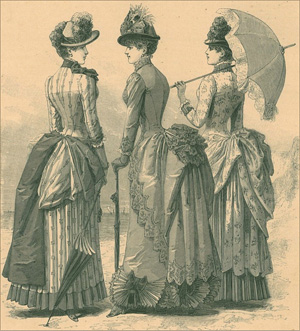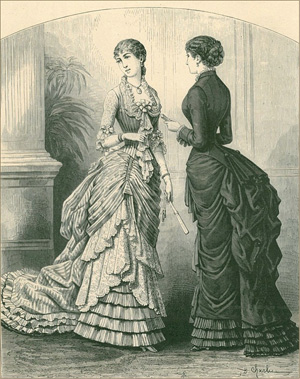2. Illustration presenting a woman’s walking costume and a woman’s ball dress from the 1880s ninete-enth century
 Click image to enlarge
Click image to enlarge
 Click image to enlarge
Click image to enlarge
Questions
Description and Analysis
- Women living in Polish lands drew fashion patterns mainly from Paris, London, Vienna and Berlin.
- Women achieved a narrow waist, called "wasp waist" with corsets.
- A bustle appeared in the 1870s. Initially it was a pile-up of draperies and ornaments, pinned at the back below the hips, alternatively supported by pillow fastened at the back.
- Big bustles with a train made it difficult to move, hence trains in ball’s dresses were sometimes smaller. Because they were uncomfortable and gave women’s body unnatural shape, they were an object of caricature. They hindered walking and sitting. Trails were stepped on by others. Putting on a dress with a bustle was not easy because other people’s help was necessary.
Geographical/Historical Context
The nineteenth century in the Polish lands was full of change. They were also present in the customs, lifestyle and fashion. Only in the nineteenth century, Paris, Vienna, Berlin, and finally London's fashion magazines reached female readers primarily landowners and bourgeois spheres. Polish magazines dedicated to fashion appeared in the late 20s. It gave Polish women a chance to keep abreast of the vagaries of fashion and feel entirely elegant Europeans. At the turn of the 60s and 70s crinoline disappeared from women's fashion . Tight bra of dress turned into a skirt, elongated at the back formed a trail. There were also drapes belting women’s hips and pinned on the back below the waist. That was the early bustle - initially it was a pile of draperies and decorations emphasizing the back of the hips. Sometimes there was a small cushion attached to the skirt . Before 1880, bustle disappeared for a short time. The skirt became narrow with extensive, decorated with trail. After 1880, bustle returned and was much larger than previously. It was a horseshoe-shaped frame, often made of steel strips like previously crinoline, clipped under a tightly laced waist. Only to this frame drapes and decorations of the skirt were pinned. Bustle, as crinoline before, complicated the problem of winter coats. Covers long on the front with the rear part ending on bustle became fashionable. Hair-dos of the era were not less complicated than the whole outfit. They consisted of a large number of small curls over the forehead and around the face and curly locks and braids at the back of the head. Hat was obligatory outside the house - in this period it was not too big, but very richly ornamented - with laces, feathers and flowers. In the mid-nineteenth century desire for convenience in men's clothing became apparent – fashiot style became looser, waistline and flared tails disappeared, silhouette became slender and has been simplified. Such a trend remained till the First World War. Top hads were commonly worn but also the bowler with a rounded top were popular. In summer men wore flat straw hats with wide dark ribbon, and the clothing for hunting and sport - baseball caps. In the second half of the nineteenth century the suit appeared- in contrast to earlier times when every part of the outfit had a different color and pattern, now jacket, vest and trousers were made of the same material in the same color.
Links
http://www.buw.uw.edu.pl/wystawy/modameska/spis_tresci.html - men’s fashion in the nineteenth and early twentieth century, in journals from the collections of the Warsaw University Library.
http://buwcd.buw.uw.edu.pl/wystawa/index.html - women’s fashion in the nineteenth and early twentieth century, in journals from the collections of the Warsaw University Libra-ry.
http://www.kajani.pl/Ryciny.html - pictures of women’ s costumes from journals of 18th – 20 century.




Presentation
Bustle - mainly used since the 1870s. It was a part of dress, emphasizing the rear hips and feminine silhouette in the shape of S. Bustle ousted crinoline. The back of the skirt began to be be adorned with swagged drapes : piled pleads were stressed with ribbons. Sometimes there was a small cushion attached to the skirt. Dresses were elongated at the back. After a short break around 1880 - when the skirt became narrow, with extensive and the richly decorated train - bustle came back much bigger than previously, sometimes being almost an engineering design, similar to the crinoline. Draperies were pinned to the dress’ framing. Bustle began to fade at the end of the 1880s.
Corset - item of clothing for women used from the end of fourteenth century to the first decade of the twentieth century. The main task of the corset is to hold the body, enhance breast, underline and slender waist line. In the nineteenth and early twentieth century corsets have reached the most complicated form of cut. They reached the middle of the hips so additionally they flattened the stomach. They were stiffened and laced in such a way that they slightly squeezed upper ribs, and the last 3-4 were bent inside, thus reducing the volume of the chest and made the breath shallow. In the vicinity of the waist, they restrained the internal organs and lead to many health problems of its wearers and even deaths. They were Pparticularly harmful for the growing organisms of children. They have been eliminated from women's clothing after World War I on the tide of emancipation.